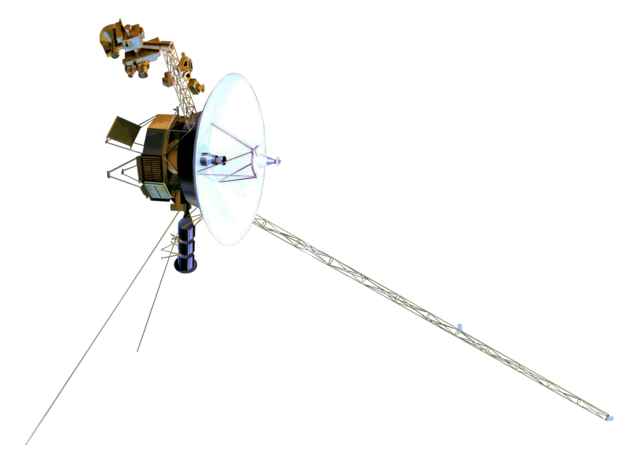
How far will the Voyager probes go? As far as they can get before they are eroded to nothing by space dust.
Voyager 1 and 2 were both launched in 1977. As of today, December 4th 2022, Voyager 1 is about 23.7 billion kilometers from the sun and Voyager 2 is about 19.8 billion kilometers away. They are so far away that it takes light 22 hours to reach Voyager 1. Over their long mission, they sent back photographs of planets and moons in our solar system. And now they are flying towards the very edge. Both of the probes are powered by plutonium batteries and, after fifty years, both of those batteries are expected to die this decade. Once they do, the Voyagers will no longer be able to send back photographs and data, they will just drift.
The probes are travelling very fast for objects launched from Earth. Voyager 1 is moving at 61,500 km/h and Voyager 2 at 48,000 km/h. Voyager 2 is slower because it was slowed down by the gravity of Neptune. Both probes had several gravity assists, which is where they use the gravity of a planet, kind of like a slingshot, to pick up more speed. However, Voyager 2 was sent to get a closer look at Triton, Neptune’s largest moon, and that brought it close enough for Neptune’s gravity to slow it down.
Both the probes might be travelling fast but compared to the size of the solar system they are barely moving. Voyager 1 travels about 523 million km in a year. Currently, astronomers believe that it is coming towards the edge of the solar system, but nobody really knows exactly where that edge is. Right now, it has left a region called the heliopause. The heliopause is the outer edge of the heliosphere and the heliosphere is the bubble created by the solar wind. When the solar wind, the charged particles, come off the sun, it is travelling at over two million kilometers per hour. The speed is so great that it pushes back the interstellar wind. As it gets farther away from the sun, it slows down because it doesn’t have enough power to push back the wind. In the heliopause, the speed slows down until it disappears completely. This is sometimes considered the edge of the solar system and Voyager 1 has now passed this, meaning it is in interstellar space. However, there is another way of judging the edge of the solar system and that is where the sun’s gravity disappears. That could potentially be a far as 2 light-years, so the Voyager probes have to go a lot farther before they reach this.
So, where will the probes go? Their trajectories don’t put them on a collision course with any other solar bodies, but who can say about the far distant future.
They will both keep going and in about 20,000 years Voyager 1 will pass through the Oort cloud, which is a body of icy planetesimals and comets that are orbiting the sun. No one actually knows, but the Oort cloud could stretch for a light-year. Once through that, there may be more clouds of different chemicals that could stop the probes. If the Voyagers make it through that in one piece, it will be into empty space.
Another 10 to 20,000 years after that, the Voyager 2 will come within 1.7 light-years of a small star called Ross 248. About the same time, Voyager 1 will come within 1.6 light-years of a star called AC+79 3888. Another 296,000 years from then and Voyager 2 will pass within 4.3 light-years of Sirius, the brightest star in our sky.
In about 302,700 years from now, Voyager 1 will come close to the star TYC 3135-52-1, and it may even come in closer enough to break through that star’s Oort cloud. And in 3.4 million years, Voyager one will come close to the star Gaia DR2 2091429484365218432. And the Voyagers will continue flying. In 500 million years, they would have orbited the Milky Way Galaxy once.
However, all of that assumes two things, which are both unlikely. The first is that the probes won’t be hit by anything. The chances of them making it through the Oort cloud without being hit by a comet are not great. And secondly, it assumes that they won’t erode.
On Earth, wind, rain and oxygen would break down the probes in a few years. Within 500 years, there would be no more trace of the probe. Space doesn’t have wind, rain and oxygen, but it does have particles. Space is not as empty as we think it is. There are clouds of interstellar dust and particles that whizz through space. Some of the particles can travel at speeds of tens of kilometers a second. They may be tiny, but if they hit the Voyager probes, they will do some serious damage. Both of the probes are carrying a golden disk that has information about Earth on it. It is doubtful that it will fall into the hands of an alien species, but it will offer the probes a little more protection from the space dust. Computer simulations have shown that at least some part of the Voyager probes will still exist five billion years from now. At that point, the Milky Way Galaxy will collide with the Andromeda Galaxy and there is no way of knowing what will happen then. If they are lucky, and avoid most of the dust, the probes could continue flying in some form for a trillion years. There is no way of knowing.
So, how far will the Voyager Probes go? There is no way of knowing, but they could, theoretically, exist for trillions of years. And this is what I learned today.
https://voyager.jpl.nasa.gov/mission/interstellar-mission/
https://www.space.com/predicting-voyager-golden-records-distant-future
https://www.smithsonianmag.com/science-nature/how-far-can-voyager-i-go-4728025/
https://www.nbcnews.com/science/space/artemis-delay-voyager-probes-rcna44188
https://iopscience.iop.org/article/10.3847/2515-5172/ab158e
https://www.syfy.com/syfy-wire/where-will-voyager-pioneer-probes-end-up

Pingback: Does the Oort cloud exist? - I Learned This Today